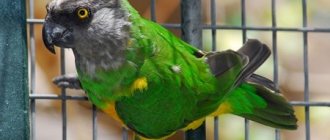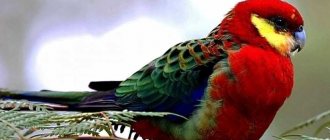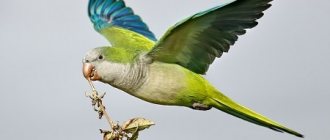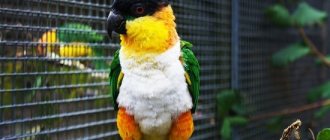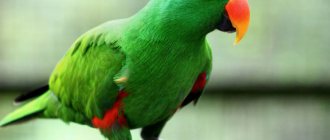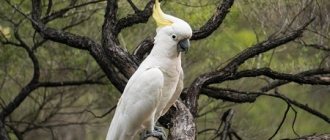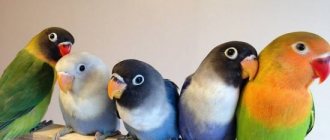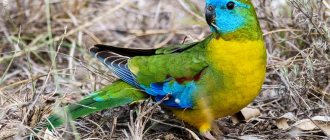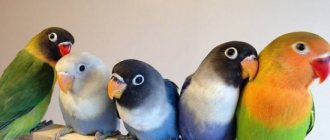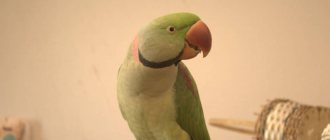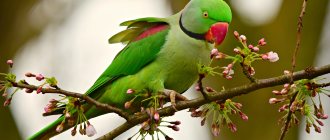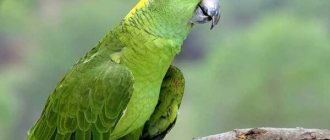According to statistics, only 5% of Russians who decide to have a pet opt for parrots. At the same time, in the homes of our compatriots, the overwhelming majority end up with not very exotic species of feathered pets.
The Rosella parrot, compared to its budgerigar, is a rare inhabitant of apartments and cottages. However, such a low prevalence of this species does not at all indicate the impossibility of keeping it at home. Rozella is an excellent parrot, very fond of human attention and communication. Such birds have strong empathy: they perfectly sense the mood of their owners and easily establish contact with them.
Appearance
All representatives of the classic “parrot” family Rosella have extremely bright, variegated and very beautiful colors. Some representatives of this species are completely painted in red tones, but the vast majority of exotic birds boast a multi-colored downy coat with a very diverse range.
The body length of such parrots ranges around 30 centimeters, and their weight is about 50 grams.
Males and females of Rosella have a small number of visual differences: it can be quite difficult to distinguish the sex of an individual. The main clue here is the gray cheeks and triangular lines ringing the back of the chick's head - it is the females that have these qualities. Rozella also has a curved, strongly rounded beak, as well as a stepped and fairly wide tail.
Buying a bird
You should only purchase exotic birds from breeders who have the appropriate documentation and positive reviews from the owners. Otherwise, there is a risk of getting a sick animal with an aggressive character. The optimal age for purchasing a rosella is 5 or 6 weeks. The older the individual, the more difficult it is to tame.
Signs of a healthy rosella:
- glossy sheen on feathers without bald spots;
- active chirping;
- no discharge in the eyes;
- paws and beak without whitish husk;
- skin without redness.
If the bird shows obvious signs of apathy, a clouded look, and when landing on a perch it lowers its wings, then most likely the parrot is sick. The breeder must provide information about the bird’s diet, its parents, and also indicate the optimal conditions for keeping it.
The bird is in good health if negative results are obtained for:
- helminthological studies;
- chlamydia;
- bacteriological research.
It would be useful to do a general blood test for biochemistry. From it, albeit indirectly, you can still judge the state of the parrot’s internal organs.
As for the cost, prices for young animals range from 6-17 thousand rubles, which depends on the subspecies, the availability of certificates of vaccinations and the health status of the pet. For example, for a green rosella you will have to pay about 7,000 rubles, while for a red one it is about 15,000.
Habitat
The real homeland of parrots of this species is Australia and Tasmania. The birds are distinguished by strong adaptation qualities to forest life, and their natural food is the seeds of trees and shrubs, as well as nectar, berries and fruits.
Today, Rozella is present in most specialized poultry houses, and is also sold as a pet in any more or less large pet store. The Rosella parrot has a lot of positive qualities, including friendliness and sociability.
Origin
Bright birds come from Australia, where the territories are spacious and sunny - all in the steppes and savannas.
Origin of the Rosella Parrot
Some representatives have chosen Tasmania and the islands nearby. They settle in city parks, in private and public gardens, and on farms. They love to communicate with people. It should be noted that this love is not always mutual.
Agricultural products are food for the chirping flock. The damage from merry parties is very great. They don’t care whether it’s fruit or wheat. The peasants are so dissatisfied that they forget about the other side of the coin. After all, it is the little birds that destroy voracious insects and seeds of all kinds of weeds on their lands. The benefits of birds are much greater than the harm.
Lifespan
The main feature that distinguishes classic Rosella parrots from other exotic poultry is their life expectancy. Unfortunately, many people have the erroneous opinion about the “fragility” of such animals, but in reality things are completely different.
The average lifespan of Rosella ranges from 15 to 20 years, of course, with proper care and the right diet.
The age of some individuals may exceed a quarter of a century - but this is rather an exception to the general rule. The Rosella parrot has a large number of positive qualities, including friendliness and sociability, which also affects everyday life and, accordingly, life expectancy.
Owner reviews
Rosella parrots love free space, so it is important to periodically let them out of the aviary or cage. This type of poultry is very friendly and tries to please the owner and his entire family. To avoid diseases, it is very important to monitor the temperature in the room, and the parrot feels most comfortable at 20-22°C . The feeder and drinking bowl should be made hanging, and the most convenient diameter of the bathtub for bathing is 20-22 cm.
However, having such a feathered pet is highly not recommended for those who have no experience in keeping parrots at all. After taming a rosella, it will need to be constantly given a sufficient amount of attention. Out of boredom and resentment, such a pet parrot becomes loud and extremely noisy, and is also capable of attracting the owner’s attention by damaging interior items. Many owners of such birds are faced with the fact that their pet “sharpens” its beak on any pliable surfaces in the room, including wires, expensive furniture and household appliances.
Varieties
Under the general name “classic Rozella parrot” there are a considerable number of subspecies, each of which has differences not only in color, but also in lifestyle and character. There are the following varieties of Roselle:
- pale-headed rosella;
- Penantha rosella;
- yellow-cheeked rosella;
- variegated rosella;
- red rosella;
- lutino rosella;
- Stanley Rosella.
In addition to the classic changes in the color scheme of the main coat, body size, tail length, weight and behavior vary from species to species. For example, the motley Rosalia has a calmer, docile character, while the ruby parrot Rosella is prone to more active communication and expression of emotions.
Price
It is better to buy rosella when it is no more than six months old. Young individuals tolerate a change of environment more easily and get used to new conditions and owners.
Their prices depend on the place of purchase, the type and age of the parrot. For greater reliability, you need to purchase from breeders with a proven reputation. The cost of the most common type - variegated rosella - is 7 - 7.5 thousand rubles.
More rare species cost from 8 thousand rubles. The price for special order copies reaches 10 thousand rubles.
For those who love birds and are willing to keep them at home, any type of rosella can become a real family favorite. And for the efforts made, he will repay you with minutes of pleasant observation, communication and melodic trills.
If you liked the article or have something to add, then leave your comments and also join our VKontakte group.
Character and behavior
As mentioned earlier, such parrots, in addition to their stunning, very bright and variegated color, stand out for their sociability and 100% friendliness towards humans. Such chicks have long adapted to the conditions of modern cities, and therefore they can often be found in the houses and apartments of lovers of feathered friends.
The classic Rosella has developed intellectual skills - with due patience and systematic training, the owner will be able to teach the parrot to speak.
The pet's speaking abilities are not amazing - on average, one trained Rozella can know up to 10 words. Due to their natural friendliness, parrots are very popular among people who prefer exotic feathered pets. The classic Rosella finds a “common language” with its owner without any problems, and does not show any whimsicality in its content.
Rosella parrot: care
Caring for birds is not difficult - you regularly need to change the filling of the bottom of the cage and wash it once a week. If a bird lives in a new cage for the first time and very quickly makes a mess there, then you need to accustom it to cleanliness: if the cage gets very dirty every day, then you still need to clean it once a week. The bird will understand that it has to live in this mess, and will become more careful. Due to the fact that she loves to swim, you need to run her under the tap or fill containers filled with warm water so that the bird can fit in completely.
Since Rosella leads an active lifestyle, you should not keep it in a cage around the clock. If the bird is not yet accustomed to its new home, then you should let it out for a walk for half an hour every day. Over time, you can add more time, and soon you can even keep the cage open regularly.
Keeping at home
The question of how long Rosellas live worries a considerable number of lovers of feathered friends. As mentioned earlier, with proper, proper care, Rosella can live a long and happy life, up to 20-25 years. However, to obtain such results, the owner will have to try to create all the necessary conditions.
Arrangement of the cage
The procedure for arranging a cage for Rozella is the simplest stage in arranging the life of a future pet. Preference should be given to spacious, roomy dwellings, the dimensions of which can fluctuate around 150x70x70 or so. In this case, you need to choose a square or rectangular cage - birds love corners, and round houses are unacceptable for them. In addition to the cage itself, you should take care of purchasing the following things:
- perch - from one to three pieces;
- feeder;
- drinking bowl;
- bath;
- toys – classic swings, mirrors, etc.
The cage must have high-quality metal bars. The fact is that copper has the unpleasant property of oxidation - chemical alloys and substances that are harmful to the health of the bird are gradually released from it.
Wooden twigs are also prohibited - they can become a container for all kinds of microscopic bugs, including the transmission of diseases.
Nutrition
The main diet may include all kinds of grain compositions and extracts, as well as classic vegetables, berries and fruits. The products needed to organize a healthy and proper diet for your feathered pet include:
- apple, pear, currant, blackberry, banana, raspberry and strawberry;
- carrots, cabbage, cucumber, tomato, radish and all kinds of greens.
Specialized dry “parrot” food can be varied with all kinds of homemade products: eggs, cottage cheese and even cheese. Rosella generally loves cookies.
You should not give preference to foods that are too salty, peppery or fatty, as well as sausage, fish and any sweets.
Bathing, care and maintenance
The number of activities necessary for the quality of life of each parrot includes bathing procedures. Bathing is an integral part of the standard life of any chick, because for them such processes are a mixture of pleasure and hygiene. In order to provide the opportunity for bathing procedures, the owner must purchase a special bath and install it in the pet’s main cage.
The liquid used is ordinary warm water (50-60 degrees), to which you can add all sorts of useful infusions and decoctions.
Caring for a parrot is very simple. The pet owner must clean the cage of food debris every day, and also change the bedding layer of his home once a day. Classic accessories present inside the cage (drinker, bathtub, etc.) are washed at least once every 5-6 days, treated with warm water and various disinfectants.
Taming
Rosella is extremely easy to tame - these are very trusting, friendly and sociable birds that love communication with their owner. You need to start working with a parrot from 5-8 months of its life: try to be closer to the pet, hand feed it and talk. Over time, a patient, affectionate and polite voice, as well as expressed friendliness towards the chick, will do the trick - the classic Rozella will definitely take food from your hands and begin to treat you accordingly.
Rosella parrot nutrition
When thinking about the diet of birds, you should think about what they eat in their homeland. The standard diet of rosella is various grains and cereal mixtures, which from time to time should be supplemented with products of both animal and natural origin.
Products of animal origin include:
- Dairy products (if the bird does not refuse to eat them);
- Boiled eggs (especially if the bird is feeding chicks or has survived an illness);
- Larvae, worms, ants, bugs;
- Bloodworm.
In addition, food for rosella should be enriched with calcium. In addition to food, there should be chalk in the parrot’s cage (it can be either special store-bought or regular chalk). To maintain the health of the beak (especially if it begins to peel off), and simply for general immunity, crushed and washed egg shells should be kept in the cage.
How to determine gender and age
Determining the age and sex of a Rosella parrot is quite difficult; often only a trained ornithologist can cope with this task. The main ways to set the age category of a particular bird include the following factors:
- Young, immature parrots have very smooth skin covering the surface of their feet.
- Rosella reaches sexual maturity at the age of 2 years: it is then that the chicks shed their “young” down and put on their “adult” plumage.
You can tell that there is a female in front of you by the pronounced triangular pattern that encircles the back of the chick’s head. Also, a good way to determine gender is the color of the cheeks - in males it is snow-white and bright. Males also have a more powerful beak, which is attached to a large (compared to females) head.
Where to buy and what to look for when buying
You can get yourself a colorful and sweet-voiced pet by visiting a specialized nursery (the best option), an advertised breeder, or a pet store.
Age
If the chick is less than six months old, you can safely buy it. An adult bird will be stressed for a long time after the move; it is too late to train it.
When buying a rozllu parrot, you should look at age
Floor
If the buyer's goal is training, it is better to take a male. When he gets used to it and acquires his first skills, he is given a pair. In this case, the female will also be very receptive, since her friend will definitely share knowledge with her when communicating.
Pet health
When choosing, it is very important to evaluate the appearance. The plumage should not have any bald spots, the general condition should be neat. On the beak and paws the color is even, the surface is smooth.
Behavior
Under no circumstances should you purchase a lethargic specimen. A healthy bird always reacts actively to any movement. It's bad if the parrot itches. This indicates one disease or another.
Necessary equipment
Bath
This representative of birds loves to swim. It is better to meet him halfway and provide him with a container of suitable size with clean, warm water.
Humidity measuring device
However, damp air is harmful to parrots. You need to buy the appropriate device and ensure that the humidity in the room does not rise above sixty percent. If it crosses the required mark, another device will be required.
Heater
It is impossible to dry the air in the room and raise the temperature to the required twenty-five degrees without it.
Need a heater to maintain temperature
Lamp
People from the tropics need warmth and light. In our climate, the sun is clearly not enough, so owners purchase a special lamp for additional illumination in order to extend daylight hours.
Preferred diet
They enjoy eating mealworms, greens, vegetables, fruits, berries, and corn (it needs to be soaked). In order for your pets to exercise their beaks and improve their gnawing skills, it is better to immediately provide them with tree branches (only permitted ones). Otherwise, it’s the end of baseboards, wallpaper and, perhaps, electrical wiring.
Communication
They adapt to captivity quickly and easily. Communication with the owner is necessary, the birds almost immediately get used to it, they always feel the mood, try to help, and communicate.
Variegated rosellas are especially good in this regard. Good-natured, calm, friendly, unpretentious. Rosellas may not speak, but they sing very beautifully.
Communication with a parrot
